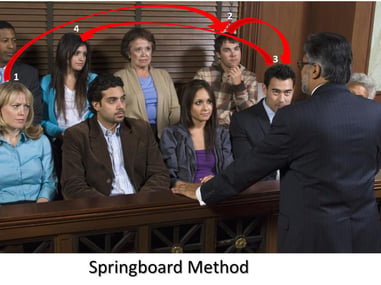December 11, 2018
Mastering Group Voir Dire: Tip 9—Employ the Springboard Method

So far, our Tips series has focused on setting the stage for effective voir dire (Tip 1; Tip 2; and Tip 3), capitalizing on open-ended questions to increase our understanding of jurors (Tip 4), avoiding the “looking good” bias (Tip 5), crafting questions with the “bad” answer in mind (Tip 6), using questions that contrast viewpoints or positions (Tip 7), and the need to intersperse majority response questions to foster continued participation (Tip 8). Our next tip addresses the springboard method of questioning that enhances juror participation during voir dire. (Click here to see a short video for this tip.)
Fostering Participation
As I have stressed throughout this series, we need to employ approaches and methods that maximize juror participation and candor during the voir dire process. We started questioning by employing the initial background summary in Tip 2 and employed the initial hand-raising technique in Tip 3 to encourage participation at the beginning of voir dire. Our focus on participation shifted in Tip 8 to the inclusion of majority response questions to counteract nonparticipation tendencies inherent in traditional voir dire questioning. There is a potentially more effective method to maintain and increase participation—the springboard method.
Springboard Method
The springboard method capitalizes on the ability of attorneys, when possible, to individually question potential jurors in the panel. The springboard method is usually employed at the beginning of a topic (e.g., viewpoints on civil lawsuits or the criminal justice system), subtopic (e.g., viewpoints on money compensation for pain and suffering or circumstantial evidence), or when a critical opinion is addressed. When using the springboard method, you first address your question to one juror and use the answer as a springboard to discuss the issue/opinion with other members of the panel. This individual questioning continues until you are satisfied with both the participation level of the panel and the diversity of answers provided (i.e. the anticipated-and sometimes unanticipated-range of answers is provided). Consider the following:
(General Topic)
Attorney: “Ms. Smith, in general, what are your views on civil lawsuits?”
Ms. Smith: “I don’t know, but there sure seems like a lot of lawsuits nowadays.”
(Follow up accomplished, and then the attorney “springboards” to another juror)
Attorney: “Mr. Jones, what are your views on civil lawsuits?”
Mr. Jones: “I feel they are needed to help those injured by others.”
Attorney: “Ms. Steward, what about you?
. . .
(Subtopic/critical attitude)
Attorney: “Ms. Smith, what are your views on providing money damages for pain and suffering?”
Ms. Smith: “I don’t like it very much since money can’t stop the pain.”
(Follow up accomplished, and then the attorney “springboards” to another juror)
Attorney: “Mr. Jones, what are your views on providing money damages for pain and suffering?”
Mr. Jones: “I feel that providing money compensation for pain and suffering is just as important as providing money compensation for economic losses.”
Attorney: “Ms. Steward, what about you?
. . .
The above individual questioning continues until the attorney is satisfied with the level of participation and diversity of answers provided or all the jurors in the box/panel have voiced their opinions.
Don’t Forget the Final Poll!
Sometimes attorneys feel that they have a good idea of the sentiments of the panel members after speaking with several jurors or, perhaps, a majority of the panel and they are inclined to go on to other areas of questioning. Not so fast. . . . The fact is that without speaking with each member, you do not know what the unquestioned jurors think or feel—a potentially disastrous situation. Therefore, it is necessary to conduct a “final” poll of the entire panel if you have not questioned each member of the panel or jury box. This poll can be tied to the opinion of interest, in general, or to the answers given by specific jurors.
Attorney: “So, I would like to get everyone’s view on this issue. How many of you feel (or agree with Ms. Smith) that, in terms of money compensation for pain and suffering, you don’t like it very much, since money can’t stop the pain?” (Counts hands)
Attorney: Thank you. “How many of you feel (or agree with Mr. Jones) that, in terms of money compensation for pain and suffering, it is just as important as providing money compensation for economic losses?” (Counts hands) Thank you.
(Attorney continues the poll if there are other responses that should be pursued.)
But, What About Dos and Don’ts?
Things are never as easy as they seem. Here are a few additional tips to consider:
Vary the recipients of individual questions. It is important to vary who is chosen for individual questioning. You do not want to have jurors feel that they are being singled out or “picked upon.” Also, by spreading the individual questions across the jury box or panel, jurors will recognize that they could be called upon at any time and, hence, must be prepared to answer.
Don’t ignore nonparticipating potential jurors. Our goal is to increase participation from all jurors. Using the springboard method to engage otherwise nonparticipating members forwards this goal.
Don’t start with cognitively challenged or reluctant jurors. Even though you want to increase participation from all jurors, you should avoid initiating the springboard method’s individual questioning with a juror who has demonstrated an inability to articulate answers or, of greater concern, an unwillingness to provide meaningful answers (e.g., providing consistent less informative or noncommittal answers such as “I would have to wait until I see the evidence,” “I don’t know,” or “I can’t say right now”). Starting with these jurors can decrease the effectiveness of the springboard method and resulting participation, thus lowering the amount and value of information obtained in the voir dire process in general. If you know you will have problems with certain jurors, save these jurors for later slots in the individual questioning sequence (e.g., the 3rd or 4th juror questioned) or, if truly problematic (in terms of levels of ability or willingness to provide meaningful and candid answers as compared to jurors simply providing “bad” answers—see Tip 6), rely on the final poll question to register their answers.
Benefits
There are two major benefits of the springboard method. First, this approach encourages jurors to stay engaged in the voir dire process. They must think about the topic and their answer/viewpoint in anticipation of being called upon to share it. Second, it forces jurors to participate, either when called upon individually and/or when the final polling takes place. In the end, you uncover more useful information on a topic/issue and both juror engagement and future participation are increased to the benefit of your overall voir dire.
Our next tip will continue examining juror participation during group questioning in terms of not letting jurors “hide” during the questioning process. We will be covering additional tips in the months to come. Check out our introductory two-minute video, Tip 1, Tip 2, Tip 3, Tip 4, Tip 5, Tip 6, Tip 7, Tip 8, and the video for Tip 9.
For more information on voir dire and jury selection, see Mastering Voir Dire and Jury Selection: Gain an Edge in Questioning and Selecting Your Jury, Fourth Edition (2018). Also, check out my companion book on supplemental juror questionnaires, Mastering Voir Dire and Jury Selection: Supplemental Juror Questionnaires (2018).
Available podcast:
Dr. Frederick presented 60-minute program based on his book, Mastering Voir Dire and Jury Selection: Gain an Edge in Questioning and Selecting Your Jury, for the ABA Solo Small Firm and General Practice Division’s November 21, 2018 session of Hot Off the Press telephone conference/podcast. Check it out at the Hot Off the Press podcast library at: https://www.americanbar.org/groups/gpsolo/events_cle/gpsolo-podcasts/2018-podcast-library/
Upcoming speaking engagements:
Also, mark your calendars for January 25, 2019, where Dr. Frederick will be presenting a CLE program entitled, “Mastering Voir Dire and Jury Selection,” at the ABA Midyear Meeting at Caesar’s Palace in Las Vegas. This CLE program is free, but you must register at: https://www.americanbar.org/groups/departments_offices/meetings_travel_dept/midyear-meeting/.



